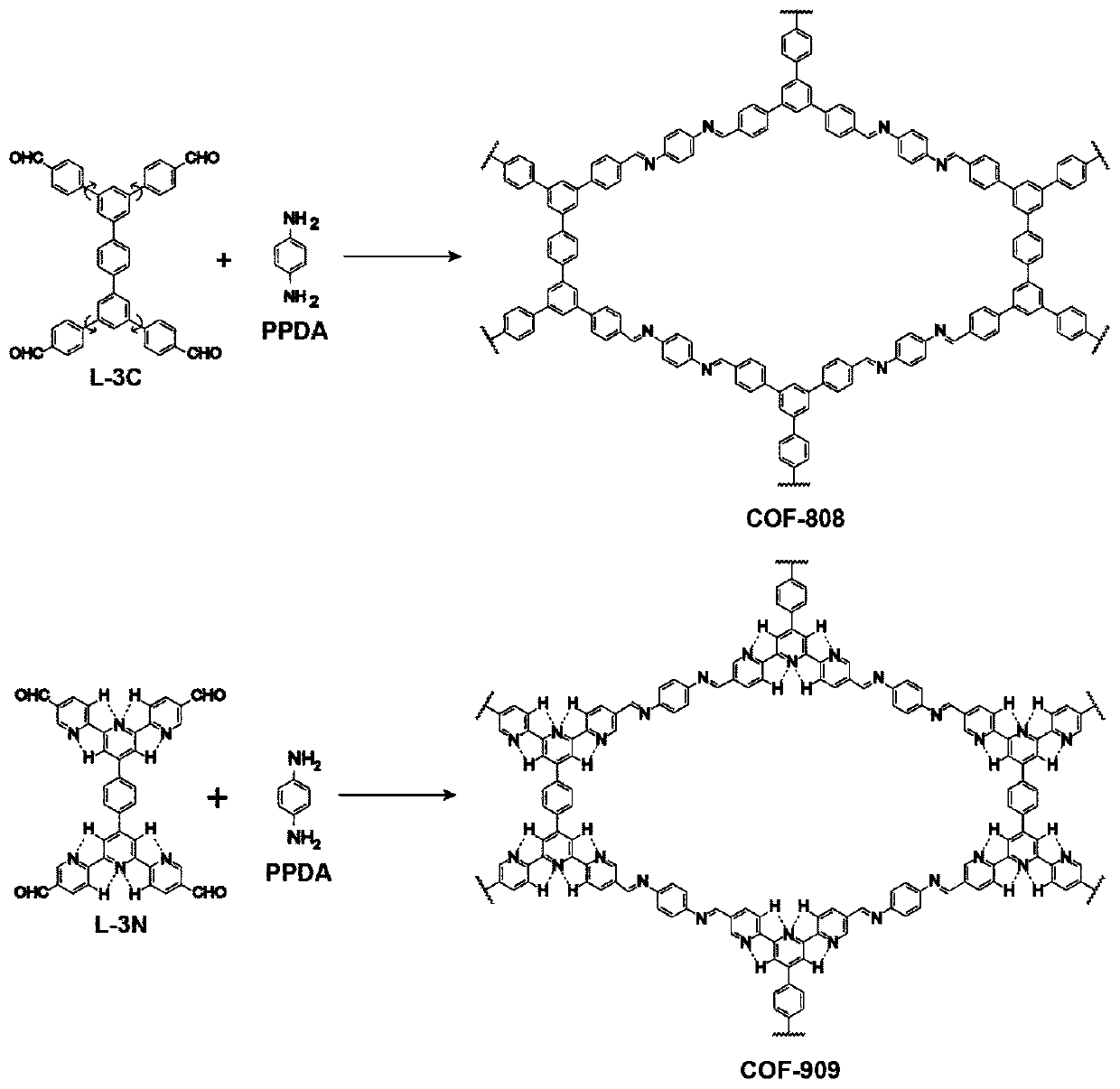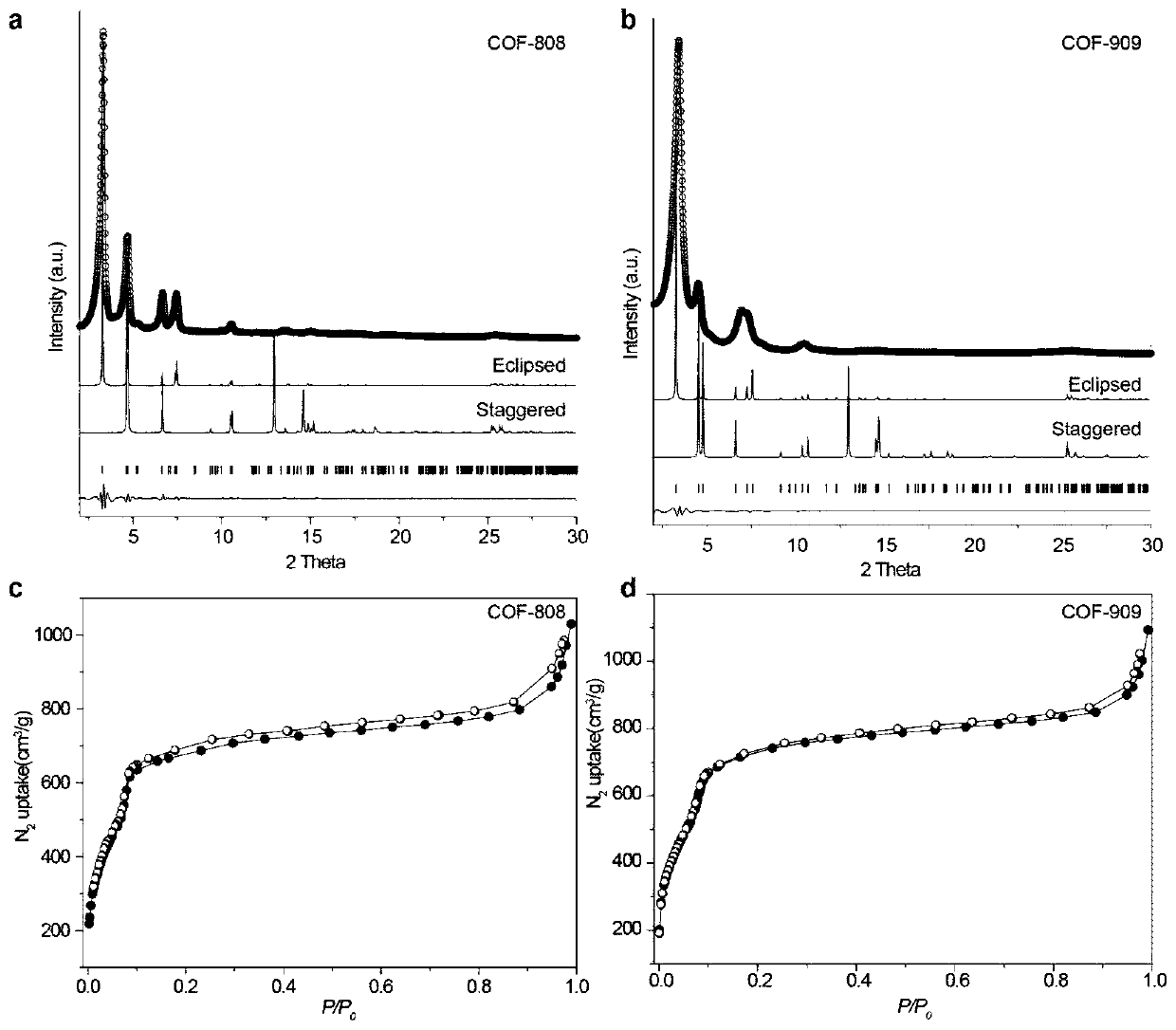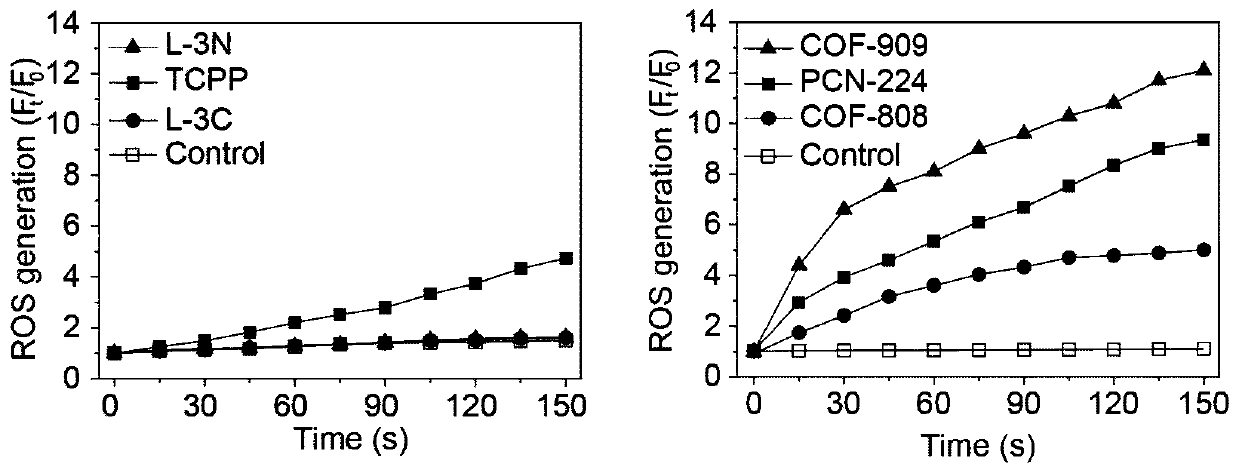Covalent organic framework material with photodynamic therapy effects and preparation method thereof
A covalent organic framework, photodynamic therapy technology, applied in photodynamic therapy, medical preparations containing active ingredients, wave energy or particle radiation treatment materials, etc., to achieve good photodynamic therapy effect, excellent tumor photodynamic therapy Effect, effect of excellent ROS generation performance
- Summary
- Abstract
- Description
- Claims
- Application Information
AI Technical Summary
Problems solved by technology
Method used
Image
Examples
Embodiment 1
[0030] Step 1): Weigh 25.9 mg, 0.24 mmol of p-phenylenediamine and 0.12 mmol of monomer L-3C dissolved in 1.5 ml of o-dichlorobenzene and 1.5 ml of n-butanol in a glass tube, and ultrasonically disperse it evenly;
[0031] Step 2): Add 0.3ml of 6M acetic acid aqueous solution to the glass tube, freeze the glass tube in 77K liquid nitrogen, then pump it to a vacuum of 30Pa with a double-row tube, then warm it up to room temperature, and then pass in argon again Place the glass tube in liquid nitrogen at 77K and freeze it with a double-row tube to evacuate to a vacuum of 30 Pa. After 3 cycles of this operation, seal the glass tube with a flame gun to prevent air leakage, and place the sealed glass tube at 90°C placed in a constant temperature oven for 7 days;
[0032] Step 3): After 7 days, take out the glass tube and wait for the temperature to drop to room temperature, then open the glass tube and filter the reaction solution to obtain a solid, then use the Soxhlet extraction ...
Embodiment 2
[0034] Step 1): Weigh 0.25 mmol of p-phenylenediamine and 0.15 mmol of monomer L-3N dissolved in 1.5 ml of o-dichlorobenzene and 1.5 ml of n-butanol in a glass tube, and ultrasonically disperse it evenly;
[0035] Step 2): Add 0.3ml of 10M acetic acid aqueous solution to the glass tube, place the glass tube in 100K liquid nitrogen to freeze, then evacuate to a vacuum of 50Pa with a double-row tube, then warm up to room temperature and then pass in argon again Place the glass tube in liquid nitrogen of 100K and freeze it with a double-row tube to evacuate to a vacuum of 50 Pa. After 3 cycles of this operation, seal the glass tube with a flame gun to prevent air leakage, and place the sealed glass tube at 120°C placed in a constant temperature oven for 3 days;
[0036] Step 3): After 3 days, take out the glass tube and wait for the temperature to drop to room temperature, then open the glass tube and filter the reaction solution to obtain a solid, then use the Soxhlet extraction...
Embodiment 3
[0038] Step 1): Weigh 0.24 mmol of p-phenylenediamine and 0.13 mmol of monomer L-3C dissolved in 1 ml of o-dichlorobenzene and 1 ml of n-butanol in a glass tube, and ultrasonically disperse it evenly;
[0039] Step 2): Add 0.3ml of 6M acetic acid aqueous solution to the glass tube, place the glass tube in 85K liquid nitrogen to freeze, then use a double-row tube to evacuate to a vacuum of 40Pa, then heat it up to room temperature and then pass in argon again Place the glass tube in liquid nitrogen of 85K and freeze it with a double-row tube to evacuate to a vacuum of 40Pa. After this operation cycle for several times, seal the glass tube with a flame gun to prevent air leakage, and place the sealed glass tube at 110°C placed in a constant temperature oven for 5 days;
[0040] Step 3): After 5 days, take out the glass tube and wait for the temperature to drop to room temperature, then open the glass tube and filter the reaction solution to obtain a solid, then use the Soxhlet e...
PUM
| Property | Measurement | Unit |
|---|---|---|
| particle diameter | aaaaa | aaaaa |
Abstract
Description
Claims
Application Information
 Login to View More
Login to View More - R&D
- Intellectual Property
- Life Sciences
- Materials
- Tech Scout
- Unparalleled Data Quality
- Higher Quality Content
- 60% Fewer Hallucinations
Browse by: Latest US Patents, China's latest patents, Technical Efficacy Thesaurus, Application Domain, Technology Topic, Popular Technical Reports.
© 2025 PatSnap. All rights reserved.Legal|Privacy policy|Modern Slavery Act Transparency Statement|Sitemap|About US| Contact US: help@patsnap.com



